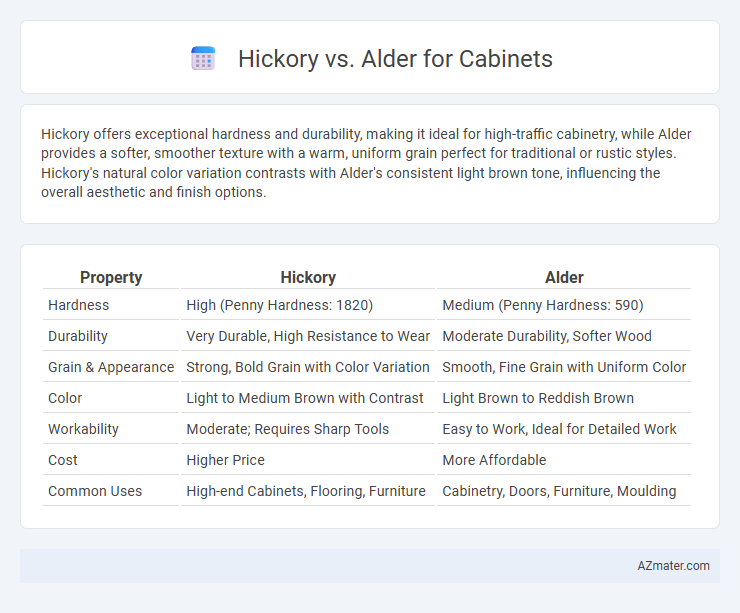Hickory offers exceptional hardness and durability, making it ideal for high-traffic cabinetry, while Alder provides a softer, smoother texture with a warm, uniform grain perfect for traditional or rustic styles. Hickory's natural color variation contrasts with Alder's consistent light brown tone, influencing the overall aesthetic and finish options.
Table of Comparison
| Property | Hickory | Alder |
|---|---|---|
| Hardness | High (Penny Hardness: 1820) | Medium (Penny Hardness: 590) |
| Durability | Very Durable, High Resistance to Wear | Moderate Durability, Softer Wood |
| Grain & Appearance | Strong, Bold Grain with Color Variation | Smooth, Fine Grain with Uniform Color |
| Color | Light to Medium Brown with Contrast | Light Brown to Reddish Brown |
| Workability | Moderate; Requires Sharp Tools | Easy to Work, Ideal for Detailed Work |
| Cost | Higher Price | More Affordable |
| Common Uses | High-end Cabinets, Flooring, Furniture | Cabinetry, Doors, Furniture, Moulding |
Introduction to Hickory and Alder Cabinets
Hickory cabinets are known for their durability and distinctive grain patterns, featuring a range of colors from creamy whites to rich browns with dark streaks, making them ideal for rustic and farmhouse-style kitchens. Alder cabinets offer a softer, smoother texture with a warm, uniform appearance characterized by light brown tones and subtle knots, lending a classic and elegant look to cabinetry. Both hardwoods are popular choices in cabinetry due to their strength and ability to take stains and finishes well, enhancing the beauty of kitchen designs.
Overview of Wood Characteristics
Hickory is a highly durable hardwood known for its strength, shock resistance, and distinctive grain pattern with varied color tones ranging from pale to dark brown, making it ideal for rustic and farmhouse-style cabinets. Alder wood is softer and more uniform in texture with a fine, straight grain and warm reddish-brown hue that easily accepts stains, offering a smooth finish perfect for traditional and transitional cabinetry. Both woods provide unique aesthetic qualities and durability levels, with Hickory being more resilient and Alder favored for its consistent appearance and workability.
Appearance and Color Differences
Hickory cabinets showcase a bold, rustic appearance with prominent grain patterns and rich color variations ranging from pale blonde to reddish-brown, enhancing a warm and textured look. Alder offers a smoother, more uniform grain with a softer appearance, featuring light tan to reddish-brown hues that darken over time for a subtle elegance. The distinct color depth and grain intensity of hickory contrasts with alder's consistent and gentle tones, making Hickory ideal for statement cabinetry and Alder ideal for a refined, classic aesthetic.
Durability and Strength Comparison
Hickory cabinets offer superior durability and strength due to their dense grain structure, making them highly resistant to dents and scratches compared to Alder. Alder wood is softer and more prone to dings, but it provides a smooth finish that can be easier to work with for intricate cabinet designs. For high-traffic kitchen environments, Hickory's robustness ensures long-lasting performance, while Alder suits projects prioritizing aesthetics over heavy wear.
Grain Patterns and Texture
Hickory cabinets feature bold, varied grain patterns with pronounced knots and streaks, creating a rustic and dynamic appearance. Alder wood offers finer, more uniform grain patterns that contribute to a smooth and consistent texture, ideal for a softer, more traditional look. Both woods provide durability, but hickory's coarse texture contrasts with alder's smoother surface, influencing the tactile and visual appeal in cabinetry design.
Price and Value Considerations
Hickory cabinets generally cost more than alder due to their dense grain and durability, making them a long-lasting investment suitable for high-traffic kitchens. Alder offers a more affordable option with a smooth texture and warm tones, providing good value for homeowners seeking style on a budget. Comparing prices, hickory ranges from $8 to $12 per square foot, while alder typically falls between $6 and $9, balancing cost with performance and aesthetic preferences.
Staining and Finishing Capabilities
Hickory cabinets offer exceptional staining and finishing capabilities due to their dense grain and natural color variation, allowing for a rich, varied finish that enhances the wood's character. Alder cabinets provide a smoother, more uniform surface that readily accepts stains and paints, making them ideal for achieving consistent, clean finishes. Both woods respond well to sealing and varnishing, but Hickory's hardness makes it more durable and resistant to wear, while Alder's softer texture is easier to work with and repair.
Best Uses and Design Styles
Hickory cabinets offer exceptional durability and bold grain patterns, making them ideal for rustic, farmhouse, and traditional kitchen designs that demand a sturdy, natural look. Alder wood provides a smoother, more uniform texture with warm tones, perfect for craftsman, transitional, and casual styles seeking a softer, refined aesthetic. Both woods perform well in kitchens and bathrooms, but hickory's hardness suits high-traffic areas, while alder's workability allows for intricate detailing and versatile finishes.
Maintenance and Longevity
Hickory cabinets offer superior durability and resistance to dents and scratches, making them ideal for high-traffic kitchens with minimal maintenance requirements. Alder cabinets require more frequent upkeep due to their softer wood grain, which is prone to dings and may need regular refinishing to maintain appearance. Both woods benefit from routine cleaning and protective finishes, but hickory's natural hardness ensures longer-lasting beauty with less effort over time.
Which Is Best: Hickory or Alder for Cabinets?
Hickory cabinets offer exceptional durability and a rustic, bold grain pattern that enhances natural warmth, making them ideal for high-traffic kitchens. Alder cabinets provide a smoother, more uniform appearance with subtle grain variation, perfect for achieving a softer, traditional look. Choosing between Hickory and Alder depends on whether you prioritize strength and rustic character or a refined, versatile aesthetic for your cabinetry.

Infographic: Hickory vs Alder for Cabinet
 azmater.com
azmater.com